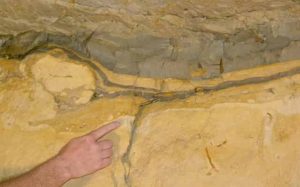
What is K-T Boundary?
The Cretaceous–Tertiary extinction event, now called the Cretaceous–Palaeogene extinction event. It may be called the K/T extinction event or K/Pg event for short. This is the famous event which killed the dinosaurs at the end of the Cretaceous period.
Sixty-five million years ago about 70% of all species then living on Earth disappeared within a very short period. The disappearances included the last of the great dinosaurs. Paleontologists speculated and theorized for many years about what could have caused this “mass extinction,” known, as the K-T event (Cretaceous-Tertiary Mass Extinction event). Then in 1980 Alvarez, Alvarez, Asaro, and Michel reported their discovery that the peculiar sedimentary clay layer that was laid down at the time of the extinction showed an enormous amount of the rare element iridium.
First seen in the layer near Gubbio, Italy, the same enhancement was soon discovered to be world wide in that one particular 1-cm (0.4-in.) layer, both on land and at sea. The Alvarez team suggested that the enhancement was the product of a huge asteroid impact. On Earth most of the iridium and a number of other rare elements such as platinum, osmium, ruthenium, rhodium, and palladium are believed to have been carried down into Earth’s core, along with much of the iron, when Earth was largely molten.
Primitive “chondritic” meteorites (and presumably their asteroidial parents) still have the primordial solar system abundances of these elements. A chondritic asteroid 10 km (6 mi.) in diameter would contain enough iridium to account for the worldwide clay layer enhancement. This enhancement appears to hold for the other elements mentioned as well.
Since the original discovery, many other pieces of evidence have come to light that strongly support the impact theory. The high temperatures generated by the impact would have caused enormous fires, and indeed soot is found in the boundary clays. A physically altered form of the mineral quartz that can only be formed by the very high pressures associated with impacts has been found in the K-T layer.
Geologists who preferred other explanations for the K-T event said, “show us the crater.” In 1990 a cosmochemist named Alan Hildebrand became aware of geophysical data taken 10 years earlier by geophysicists looking for oil in the Yucatan region of Mexico. There a 180-km (112-mi.) diameter ring structure called “Chicxulub” seemed to fit what would be expected from a 65-million-year-old impact, and further studies have largely served to confirm its impact origin. The Chicxulub crater has been age dated (by the 40Ar/39Ar method) at 65 million years! Such an impact would cause enormous tidal waves, and evidence of just such waves at about that time has been found all around the Gulf.
One can never prove that an asteroid impact “killed the dinosaurs.” Many species of dinosaurs (and smaller flora and fauna) had in fact died out over the millions of years preceding the K-T events. The impact of a 10-km asteroid would most certainly have been an enormous insult to life on Earth. Locally, there would have been enormous shock wave heating and fires, tremendous earthquake, hurricane winds, and trillions of tons of debris thrown everywhere. It would have created months of darkness and cooler temperatures globally. There would have been concentrated nitric acid rains worldwide. Sulfuric acid aerosols may have cooled Earth for years. Life certainly could not have been easy for those species which did survive. Fortunately such impacts occur only about once every hundred million years.
What killed the dinosaurs?
Dinosaur fossils are only found below the K/T boundary. This shows they became extinct before, or during the event. Mosasaurs, plesiosaurs, pterosaurs and many species of plants and invertebrates also became extinct.
Mammalian and bird groups got through the event with some extinctions. Those that survived became widespread and varied during their later evolutionary radiation.
Scientists think the K/T extinctions were caused by something sudden and powerful, such as one or more massive asteroid or meteor impacts, and increased volcanic activity.
Scientists study what happened to the dinosaurs and other groups to learn what caused the K/T extinction event. How quickly they died out around the world is an important clue.
Scientists also study patterns in rocks to learn the causes. Several impact craters and massive volcanic activity, such as that in the Deccan Traps in India, are dated to about the same time as the extinctions. Those impacts and volcanoes would have reduced sunlight and hindered photosynthesis, disrupting Earth’s ecology.










